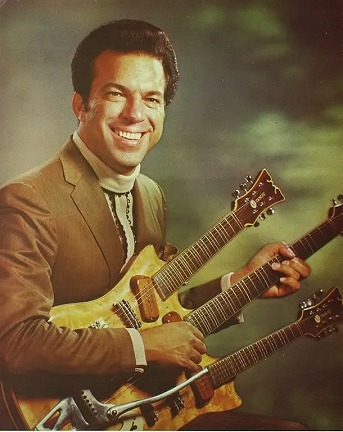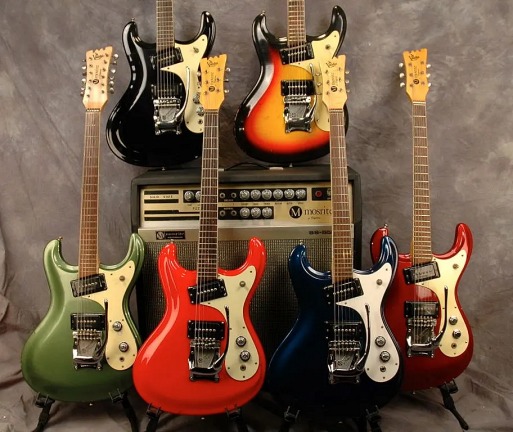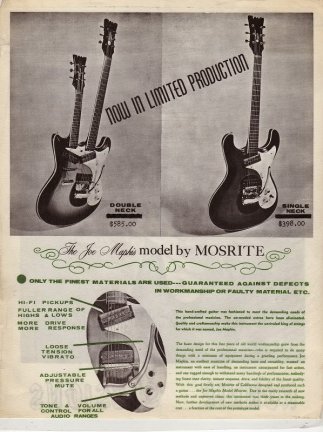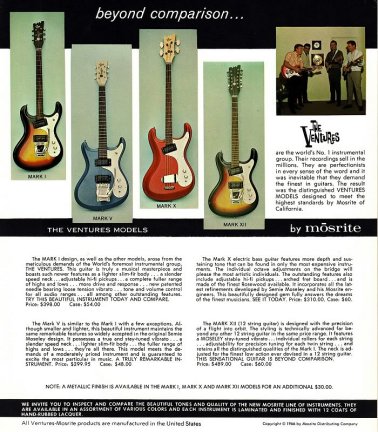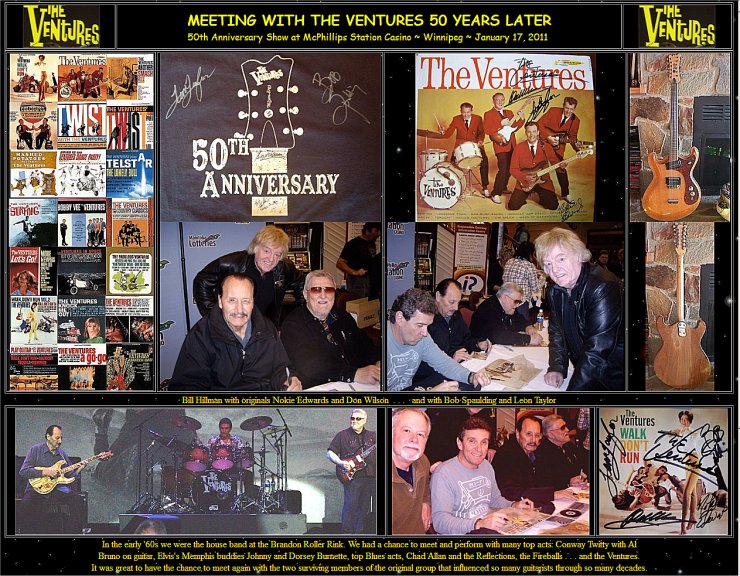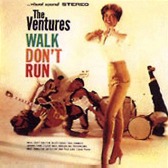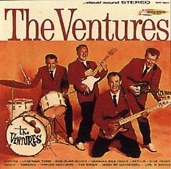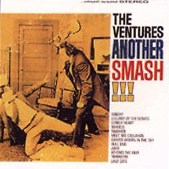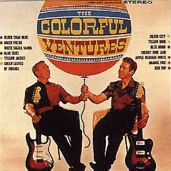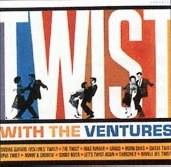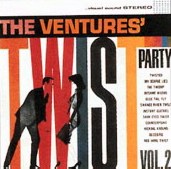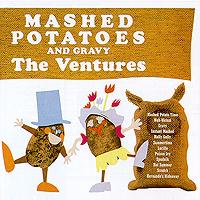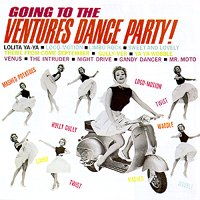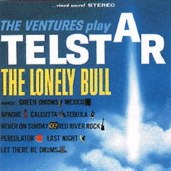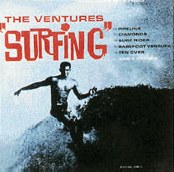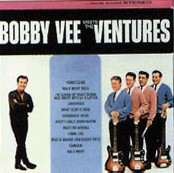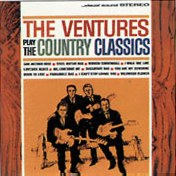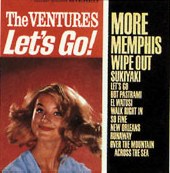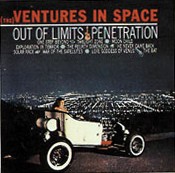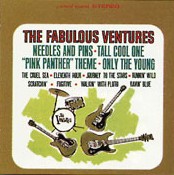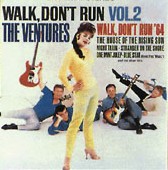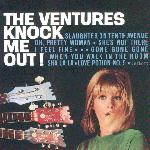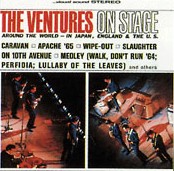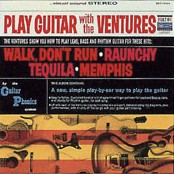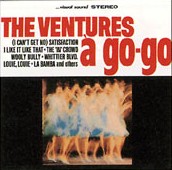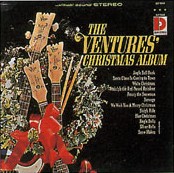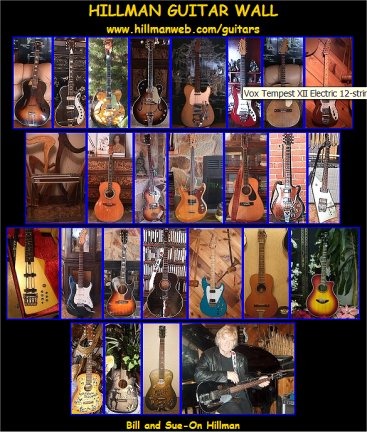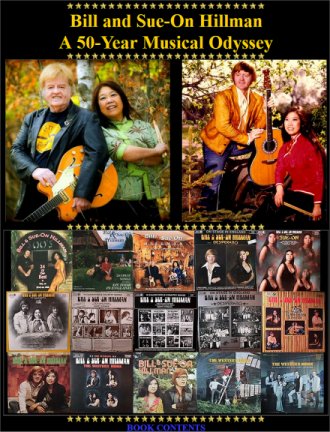
BILL AND SUE-ON HILLMAN: A 60-YEAR MUSICAL ODYSSEY
www.hillmanweb.com/book
Gig Notes
Presents
Hillman Guitar No. 14
Mosrite Electric Mark XII 12-String
www.hillmanweb.com/guitars/g14.html
.
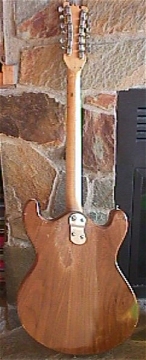 In the middle of a trading binge in the '80s I worked out a swap with local guitarist Doug Strange. I traded a Randall bass amp for a guitar which had fascinated me since my "Ventures days." Most by-ear guitar players who were trying to learn their craft in the early ‘60s were fans of this instrumental quartet. During my Brandon University years, starting in 1961, my noon hours were spent performing a live daily show on CKX-TV, my afternoons were spent at the Strand Theater catching the matinee and my evenings were devoted to jamming and rehearsing with one of the 3 or 4 bands I was playing with at that time . . . the grades were not great.
In the middle of a trading binge in the '80s I worked out a swap with local guitarist Doug Strange. I traded a Randall bass amp for a guitar which had fascinated me since my "Ventures days." Most by-ear guitar players who were trying to learn their craft in the early ‘60s were fans of this instrumental quartet. During my Brandon University years, starting in 1961, my noon hours were spent performing a live daily show on CKX-TV, my afternoons were spent at the Strand Theater catching the matinee and my evenings were devoted to jamming and rehearsing with one of the 3 or 4 bands I was playing with at that time . . . the grades were not great.One of the bands I worked with was managed by the owner of the Brandon Roller Rink who used to bring in some of the top artists of the day. We were employed as the house band for this huge rink located near the old Brandon Arena and which doubled as a show and dance venue. This was a good excuse to catch and rub shoulders with every act he brought in: Conway Twitty with Al Bruno on guitar, Elvis’s Memphis buddies Johnny and Dorsey Burnette, Chad Allan and the Reflections with Randy Bachman on guitar, the Fireballs . . . and the Ventures. One of my hobbies at that time was to collect behind-the-scenes anecdotes . . . and guitar picks from the performers . . . but the main reason for attending was to drool over the guitar licks displayed by the full-time professional lead guitar players.
Meeting these California guitar greats and actually seeing them in action was one of the highlights of these early years. When I saw the Ventures in the early '60s they played Fenders. They had mentioned that the reason their Fender instruments weren't all featured on their first album cover - Walk Don't Run - was that they were touring when the photo was taken and the photo actually featured model stand-ins. A few years later, during their boom years, as part of an endorsement deal, they played Mosrite guitars exclusively. The unique shape of the Mosrite supposedly came about when the designers traced the outline of a turned-over Stratocaster.
One of the previous owners of the the Mosrite I took possession of had strung the instrument with six strings . . . ordinarily not that unusual a procedure, but this model was actually a 12-string guitar. As with all Mosrites, the neck is incredibly thin and easy to play -- and the instrument has quite a distinctive sound. It has an alder body, featuring the "German carve" perfected by Mosrite founder Semie Moseley. The thin maple neck is topped with a 24.5" scale rosewood fretboard and Klusons tuners.
It has an honoured place on my guitar wall.
Born on September 29, 1930, American singer, songwriter, guitarist Billy Strange was a session musician with the famed Wrecking Crew. Known as "The King of the 12-string Guitar" Strange played on hundreds of sessions. That's Strange on 12-string on Dino, Desi & Billy's "I'm A Fool", for example. He appeared on hit songs for Elvis Presley, including "A Little Less Conversation" which he co-wrote with Mac Davis, Nancy and Frank Sinatra's "Somethin' Stupid" and worked with The Ventures, Willie Nelson, The Everly Brothers, Dino, Desi & Billy, Wanda Jackson, Sonny & Cher, The Beach Boys, Randy Newman, and Nat King Cole, among others. Strange recorded arrangements of James Bond movie themes for GNP Crescendo Records and provided the instrumental backing and arrangement for Nancy Sinatra's non-soundtrack version of "You Only Live Twice". Strange played guitar on numerous Beach Boys hits including "Sloop John B" and the Pet Sounds album. Strange played themes for such TV shows as "The Munsters" (1964), "Batman" (1966), and "Have Gun – Will Travel" (1957). He is the guitarist heard on the theme to "The Munsters". Strange released a number of solo instrumental albums including Billy Strange Plays Roger Miller, Mr. Guitar, and English Hits of '65.
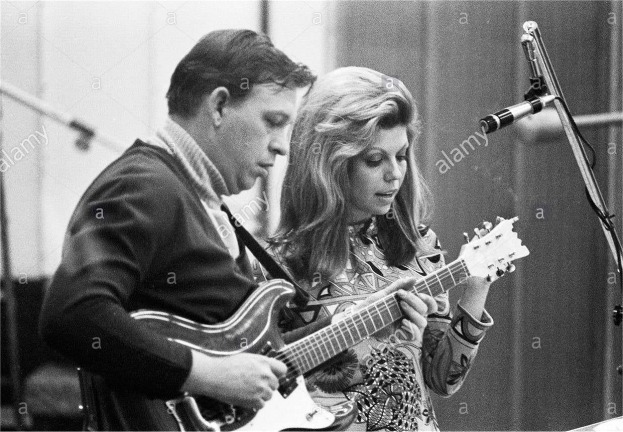
Billy Strange and his Mosrite 12 in the studio with Nancy Sinatra
Billy Strange died on February 22, 2012, aged 81.~ Reference: Music Historian John Einarson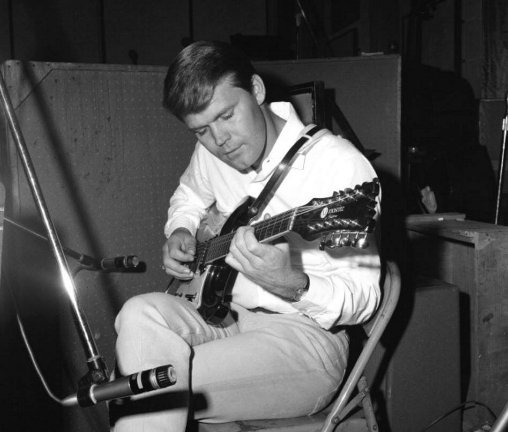
Glen Campbell playing a Mosrite XII String
at an Everyly Brothers recording session.
From our Everly Brothers Tribute
www.hillmanweb.com/everly
Semie Moseley was born on June 13, 1935 in Durant, Oklahoma. His family migrated to California along a path similar to many “Bakersfield Okies”, first moving to Chandler, Arizona in 1938, and two years later in Bakersfield, California. In Bakersfield, Moseley started playing guitar in an evangelical group at age 13. Semie and his brother Andy experimented with guitars since teen-age years, refinishing instruments and building new necks.
Semie built a triple-neck guitar (the longest neck was a standard guitar, the second-longest neck an octave higher, the shortest was an eight-string mandolin).
Semie's triple neckSemie Moseley became a master luthier after he apprenticed with Paul Bigsby and later at Rickenbacker with Roger Rossmeisl, a German born jazz guitarist and talented luthier. During this time he mastered the art of the “German Curve” body style that was later employed on his Mosrite guitars. By 1956, with an investment from Reverend Ray Boatright, a local Los Angeles minister, Semie and Andy started their company, Mosrite of California. Semie, who built guitars for the L.A.-based Rickenbacker company, said to his co-workers that he was making his own product, and he was fired by Rickenbacker. The name “MOSRITE” comes from a marriage of these two names MOS (Moseley) RITE (Boatright).
After a few years of struggling in Los Angeles trying to turn Mosrite into a mass producing guitar building operation, Semie moved his small operation in Oildale, just outside Bakersfield, California. When they began, their production was all custom, handmade guitars, built in garages, tin storage sheds, wherever the Moseleys could put equipment.
Guitars that Semie built were quite different, and original. They weren’t copies of Fenders or Gibsons – Mosrite guitars had many unique features including ultra-slim necks, zero frets, high output handmade pickups, custom built aluminum hardware, and double cut-a-way body shapes had the lower horn longer. Quite a different guitar. Ultra fast players like Joe Maphis and Larry Collins loved their playability for their “shredding” style in the 50s and 60s.
Semie and Mosrite struggled to survive in Bakersfield, trying to work their way out of the tin shed in Oildale. Other guitar guys like a young guitar maker named Bill Gruggett were attracted to the usual guitars Mosrite was producing and became an employee. Joe Hall a R&B musician, became an employee a different route. Joe sold his Gibson ES-147 and paid $400 in advance for a custom order with Semie Moseley. This was quite a lot of money in the early 1960s. When Semie did not deliver, Joe Hall wound up working with Semie, learning guitar making and later founding Hallmark Guitars with the help of Bill Gruggett.
In 1959, Andy moved to Nashville, Tennessee for a year to popularize the Mosrite name and sold a few to Grand Ole Opry entertainers, people, and to road musicians. Andy said: “And that’s how we kept the factory going at the time: custom guitars”.
Semie Moseley was a great guitar builder and innovator, but struggled as a businessman. Semie once made a deal with Bob Crooks to make guitars for Standel the amplifier maker, that claimed to have interest in a guitar line to go with their amps. This deal folded after ten units made for the NAMM show. These guitars are the early, very primitive models with a single cutaway that looked a bit like a Fender Telecaster.
Mosrite guitars became known as the most sought after boutique guitar in the world. They were about twice the cost of Fender Stratocaster. Early Mosrite guitars used Carvin pickups. Later Semie made his own pickups. Far superior to other bridge systems at the time the Mosrite “Vibramute” bridge system. All materials for Mosrite guitars were made in house during this time except for the tuners. The Mosrite “Fuzzrite” was the premiere guitar distortion device of the time. The Fuzzrite was used by many players of the era, most notably Jimi Hendrix
Semie eventually hit gold with a chance meeting with Nokie Edwards from the Ventures. Nokie, played Fender guitars, but loved the Mosrite models he tried. Soon the Ventures model Mosrite was born bringing hundreds of thousands of dollars to Semie Moseley as the Ventures was one of the most popular instrumental bands in the world. Mosrite and Surf music were forever associated after this. This deal finally had Mosrite mass producing guitars.
Sears and Roebuck, who had already owned the Harmony Company since 1916, offered to purchase Mosrite for over a million dollars. Semie passed on this lucrative deal because he claimed his name was on the guitars, so he just couldn’t sell the brand name away.
He and Andy also got into the recording business by establishing Mosrite Records. They signed Barbara Mandrell, a teenage daughter of Irby Mandrell, an Oceanside, California music-store owner who sold Mosrite guitars. They also signed guitarist Ronny Sessions and others.
Mosrite guitars were played by many rock and roll and country artists such as Jimi Hendrix, The Ventures, The Ramone’s Tommy Tedesco, The Strawberry Alarm Clock, Davie Allan, Kurt Cobain, Joe Maphis, Buck Owens, Larry Collins, Buck Trent, Nick McCarthy, the MC5, Iron Butterfly, Dottie Rambo. Arthur Lee Love, Fred Sonic Smith, Ricky Wilson, Kayama Yuzo, and Kevin Shields. Players like Brian Wilson of The Beach Boys, Jimmy Page, Duane Allman, Roy Buchanan, Glen Campbell, Larry Gatton and Rick Springfield have had Mosrite guitars.
At the peak of production in 1968, Semie and his brother Andy, with their crew of 107 employees were making 1,000 Mosrite guitars per month which included acoustics, standard electrics, double-necks, triple-necks, basses, dobros, even mandolins.
Mosrite of California went bankrupt in late 1968 after they contracted with a competitor to market their guitars. After this, they tried to deal directly with stores, and they sold 280 guitars in 1969 before they came to the shop one day and found their doors pad-locked.
Two years after his bankruptcy, Semie was able to get back the Mosrite name, and in 1970 he started making guitars again in Pumpkin Center near Bakersfield. He moved his factory three times in the next 20 years, to Oklahoma City in the mid-70s, to the township of Jonas Ridge, in Burke County, North Carolina in 1981, and to Booneville, Arkansas in 1991.
Six months after moving to Arkansas, Semie Moseley became ill with bone cancer and six weeks later, in August 1992, he died.
~ Ref: chasingguitars.com

COMMENTS FROM MOSRITE OWNERS
Gleaned from the Web
References:
Harmony-Central Website: Fan Reviews* A 22 fret maple neck with bound rosewood fingerboard and the smallest frets known to modern man.
* They used small size frets and then milled them down super low for extremely fast action.
* The body is the familiar flipped over Strat design with German carved top.
* The body is, I believe a light alder or basswood.
* Tuners are Kluson 3 x 3 with the Fender style slot on top which is the best kind of tuner IMHO.
* Pickups are Mosley single coils which look like shorter fatter P-90s but these babys are HOT!
* Front measures 10.75 ohms, rear 11.33. Here is where the unique clean yet gritty Ventures sound comes from.
* Ventures Mosrites have a great sound, period, the end. I don't care which one you plug into the sound is there.
* The middle switch position is especially fine. By fooling with the tone pot and picking position a full pallate of
sounds is easy to find.
* The guitar leans towards the bright side but a nice Gibson-like woody neck
tone is also possible.
* Mosrites were virtually hand made since they were always a small outfit.
* This axe is 33 years old with less than caring owners over the years and it's still kicking up
* But these guitars require very little maintainance.
* The Ventures Mosrite Mark I is one of my very favorites along with the 59 Gretsch 6120,
LP Junior and Custom and the reverse Firebird V.
* The Mosrites play like butter - Listen to any vintage Ventures recording, Nokie Edwards was bending, hammering, pulling off like crazy!
* The vibrato is one of the most sensitive I've ever played and nearly alway comes back in tune unless you really go wild with it. * A great looking, unusual, and top sounding and playing guitar.* Adjustable pick-ups. Locking tuners. Kluson keys. Mosrite pick-ups. Skinny neck
* It has a small buzz close to the amp or with volume loud.
* I like the bright sound and action but I can make the sound mellow with the three way switch or the tone knob.
* It is a well made, solid guitar. Feels like it was made to be played hard and long.
* The finish is almost too thick which has led to checking
* The strap buttons are screwed into the body very solid.
* It has a three way selector switch, 1 volume, 1 tone control and a mono imput jack.
* The body is the standard upside down "strat" shape but with no binding.
* The neck is short scale.
* It has original Kluson tuners with white buttons.
* It has low frets and the neck plays like a dream for a short scale. It came with a hardshell case.
* This guitar sounds great! The pickups are very strong and punchy.
* There is no way to acurately describe the tone on these babies cause there's nothing else like them!
* The only problem is the shortscale neck makes it imposible to play the upper frets so I can only use it on bass string songs or as a rythym guitar.
* This guitar is built to last - it's solid as a rock.
* The finish on the neck hasn't even faded yet and the and the electronics hardly hum when standing close too the amp.
* I wouldn't feel safe gigging without a backup because the guitar guzzles strings like mad.
* These guitars are fantastic for a number of styles. They handle surf, blues, British invasion, and country wonderfully.
* It's more of a rhythm guitar a than lead guitar (A lot like a Ric 325) but with an unmistakable sound.* Fretboard is rosewood. This guitar more or less has no frets, making any movement on the neck absolutely smooth.
* You can tell that this guitar was built by people who care. The weight, look, and feel are incomparable.
* I use this guitar for everything. Yes, it is a bit hard to do bending on the neck, because the damn frets are so close and short, but for the most part, that is not a problem.
* This guitar is absolutely necessary for any kind of surf
* The major selling point of this guitar is its sound, a kind of airy dry sound that is unique to "cheap" guitars of the sixties, the sound that all good guitarists love.
* Just plain raunchy under distortion (Fuzzrite, of course), and amazing when coupled with a nice reverb tank (Fender, once again-- no Venture would use anything else, right?).
* The tremolo arm is absolutely without peer-- not as extreme as a Fender, but with a real personal touch that cannot be duplicated by anything else but a Gretsch or vintage Gibson Bigsby; the tremolo is so easy and rich-sounding that if you have any need for it, it will make you think twice about buying anything else, ever.
This guitar sounds tons better, than a Jazzmaster and is so easy to play, it should be a sin. No guitar can
compare to this one.
* The action is amazing, just playing once on a Mosrite is a religious experience. This guitar looks beautiful, slung around your waist or sitting in a corner, it is instantly recognizable.
* Somehow this guitar fits me like a glove, no matter how low I set the strap.
* The pickgaurd is white 3 ply that has aged to a lovely green like Fenders of that era.
* The action is lower than on any guitar I've ever played (and still be quite useable)
* The guitar came with an "alligator" case.
* The bridge pickup is really bright. I love the way the tone control actually does something on this guitar.
* I own about 15 guitars, this sounds as good as any of them.
* This neck is as thin as any new Ibanez, pretty amazing for 1967.
* The finish is great, old Mosrite ads claim they use 12 coats of hand applied laquer, and I can believe it
* Getting info on Mosrites, since Semi died, is pretty non-existent. The only help I got was from some Japanese Ventures fan sites.
* This guitar was love at first strum. Its kinda like owining a cheap Ferrari, its still a Ferrari.* The Ventures model was built in the North Carolina Mosrite Factory.
* This guitar has a really full sound, making it a great rhythm instrument (ask Johnny Ramone!). But it was designed for a music group which was keyed on melodic solos (the Ventures) and does play well with a little practice
* It has huge tonal variety, even though it only has two knobs. The reason is that these knobs actually change the sound considerably with each turn, not like other guitars with 20 knobs that do next to nothing.
* Semie Moseley was known far and wide for his guitar painting.
* This is a great guitar- a keeper as they say. Its rather unusual in shape, mechanics and playability, but NOT debilitatingly so. The guitar has a charm. You don't have to fight it like a strat.
* The shape is completely ergonomic, and I'd like to see other companies use it in the future.
* 22 frets on a rosewood fingerboard. Very thin bound neck. Frets are very low and called "speed frets" similar to gibson "fretless wonders." This makes it virtually impossible to bend strings, hammer on and pull off, or vibrato, so you
have to pick just about every note. This is what is bad about this guitar.
* The sound of this guitar is best suited to clean 60's California surf and pop music, but sounds good for jazz as well. Due to the unique pickups and their placement, the guitar has a distinct sound which is warm, yet with a trebley twang to it. Not much sustain due to the low frets.
* Definitely not a guitar for displaying awesome technique on. I do not enjoy playing this guitar from a technical standpoint because you physically can't play lots of things on it due to the low frets, and a refret with larger frets would kill its value.
Notable players
https://en.wikipedia.org/wiki/Mosrite
Billy Strange (of the Wrecking Crew. . . and studio session man on countless hit records)
Johnny Ramone (of the Ramones)
Fred "Sonic" Smith (of The MC5)
Dave Alexander (of The Stooges)
Michael Davis of The MC5
Drake Levin (of Paul Revere & The Raiders)
Kurt Cobain (of Nirvana)
Jerry Cantrell (of Alice in Chains)
Davie Allan
Erik Brann (of Iron Butterfly)
Toulouse Engelhardt
Glen Campbell
Kevin Shields (of My Bloody Valentine)
Brian Causey (of Man or Astro-man?)
Larry Collins (of The Collins Kids)
Lee Dorman (of Iron Butterfly)
Art Greenhaw
Susumu Hirasawa
Johnny & The Hurricanes
Koichi Kawasaki
Y?z? Kayama
Joe Maphis
Efrim Menuck
C.J. Ramone (of Ramones)
Izzy Stradlin
Takeshi Terauchi
The Ventures
Love
Robert Smith (The Cure)
Ricky Wilson (The B-52's)
Kevn Kenney (Drivin N Cryin)
The body shape that is most often known as the "Ventures-style" body was developed around 1961 or 1962 when Bob Crooks of Standel wanted Semie Moseley to build some Standel guitars for him. He suggested to Semie that he take the shape of a Fender Stratocaster, flip it over and trace it. Semie supposedly did just that and the famous shape that we know was born.
Around 1961 or 1962, the "Mosrite Joe Maphis Model" single-neck and double-neck guitars made their debut. Joe Maphis, the famous country picker, was promised his own signature model guitar, and these guitars were the "Joe Maphis Model" guitar. Above is a flyer that promotes this early model. Note the examples in this flyer have wood pickup covers.
Nokie Edwards, guitarist for The Ventures, played a Joe Maphis-style model that belonged to Gene Moles, a buddy of his in Bakersfield. Nokie borrowed the guitar and the group liked the design and how it sounded. The group had been wanting to market a signature guitar and bass of their own, and they decided to ask Semie Moseley if this guitar could be the Ventures model guitar.
Semie Moseley jumped at the chance to have a hit rock and roll group endorsing his guitars. The group had capital to infuse the company with, and so for the time being Joe Maphis's signature model was put on hold. The "Joe Maphis model" guitar became "The Ventures" model guitar. The first few guitars shipped in late 1963. They were exactly the same as the Joe Maphis guitar, but the headstock now said "The Ventures."
Read more:
http://www.premierguitar.com/Magazine/Issue/2011/Oct/1966_Mosrite_Mark_XII.aspx#ixzz29iotAtjT
A day with Semie Moseley "Mosrite" on YouTube
Nokie Edwards playing Mosrite Forever in Japan in 1991
Dana Moseley and Mosrite Guitar

